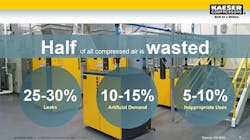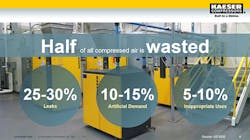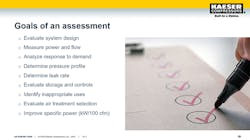Optimization best practices for compressed air systems
Neil Mehltretter, engineering manager for Kaeser Compressors, Inc., is the author of several nationally published articles on compressed air system optimization and has often presented on energy-efficient system design. Werner Rauer. rotary screw compressors product manager for Kaeser Compressors, Inc., is an active leader in the Compressed Air and Gas Institute (CAGI), and helped develop the CAGI compressor performance datasheets. During the webinar “Compressed Air System Optimization Best Practices” Mehltretter and Rauer discussed how to drive out demand-side inefficiencies in compressed air systems.
PS: How do I know if I'm experiencing high demand events?
NM: You can see that in a multitude of ways. In the compressor room, short cycling is a possible indicator. In the plant, periodic malfunction of pneumatic equipment is another sign that a big demand is stealing air from neighboring areas. After a while, the operators get to know when they cannot use other equipment because a particular machine or process is going. It is not uncommon to hear that the plant can run on 80 psig but when a particular piece of equipment is in use, they can't run the other pieces of equipment because pressure drops too low. This sometimes causes them to turn up the main pressure, which uses more power but doesn’t really help.
WR: Sometimes walking through the compressor room and listening, because most of the air gets exhausted, sometimes the repetitiveness actually can give you a sign, and sometimes the intensity can also give you a little bit of high demand events experience.
PS: What is a typical range of required equipment velocity?
NM: In the compressor room, we typically say 15 feet per second. In the distribution network, we typically say 30 feet per second. And then at the point of use, 45 feet per second. That may differ, because many points of use have additional filtration, regulators or point of use storage. These things impact air velocity near the point of use.
In line filtration is another factor. Let’s say your filter is rated for 500 cfm, but it's a 1.5-inch connection, but the recommended network pipe size might be 2 inch. Why do you neck down? Some of that has to do with impingement and making sure that we have the necessary pressure drop across whatever device it is, so we can get enough contact, and that's probably the same affect that a point of use would have as well.
PS: In order to initiate an audit, is there a standard template or questionnaire that you can share? How do you support this initiative?
NM: We have a form we use to help collect all the information needed about the compressed air station. On the supply side, what are the compressors? What are the ages? What are the control types? It prompts you to document the system including system target pressure, load/ unload pressures, type of controls (e.g. modulation pressure, VFD, etc). Plus details about master controls, storage volume and locations, pipe size, and all the air treatment equipment. You want it to be comprehensive. And system sketches help too.
We also have a simple set of questions on our air auditing brochure that just says, "Hey, do you have these particular problems in your plant?" It's a great way for you to get a feel for what's going on. This is, let's say, the first time that I've had a customer come to me and ask for a questionnaire. Normally, we go to them and say, "Okay, let's fill these things out."
WR: Over the decades I have seen air system questionnaires change from rudimentary one-pagers to much more comprehensive (and helpful) documents and spreadsheets. Probably about 8 pages if you printed it all out. Getting this information down up front reduces chances of bad assumptions in the evaluations and saves time.
PS: What is the acceptable pressure drop in piping systems?
NM: It all depends on what you're willing to accept. The Compressed Air Challenge generally recommends you limit it to 10%. From whatever your operating pressure is in the compressor room, to the point of use before you start taking that demand is 10%.
Let's say if we had a 100 psi operating system, 10% of that is 10 psi. When you consider that rule of thumb for every 2 psi is a 1% increase or decrease in energy, that 10 psi is going to be 5% of your energy cost. You want to minimize that as much as possible.
What happens is systems grow over time as well. From my perspective, one of the examples we gave from an optimized system earlier was 1.5 psi in the distribution network and 1.5 psi in the point of use, so that comes out to 3 psi total. The system was operating at 125 psig so the loss percentage was low, but that’s not counting the losses upstream through dryers and filters. But the lower you can go, the better off you're going to be. And it's a cost benefit. If I say I want to go with a 2-inch piping system, well, let me see what the quote is for a 3-inch piping system. Maybe that's $10,000 for the installation now, but that's less than the money you're going to spend later if you expand. 10% would be the maximum I would be happy to go with but lower, 3%, would probably be a really good choice.


